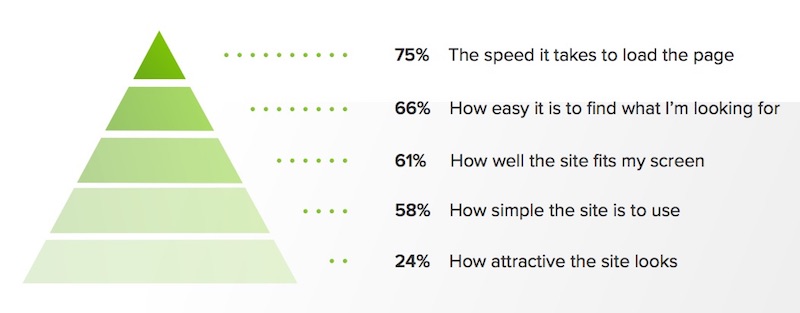One topic that keeps cropping up in the digital marketing industry, is speed. Whether your aim is to have a faster site than your competitors, to provide more immediate answers for users, or to reduce bounce rate and abandonment from customers who don’t have time to wait for your site to load; site speed and performance is a topic that catches everyone’s attention.
Access the Downloadable PDF Version of this Guide
Site speed and the user
All performance optimization initiatives should be tailored to the biggest pain points your users face on your site. The first ideas that might come to mind could be around fixing an unclear navigation or a poorly designed product page template. However, before any of that can matter to the user, they have to be able to load and access your site in the first place. Optimization needs to start with speed.
Think about it, what value can a user gain from your site before a page has actually loaded? This is why site speed is the number one issue in the user experience hierarchy.

Source: Google I/O 18
As technology continues advancing and we have access to immediate answers on more devices, our society continues to lose patience. Wait times aren’t an option anymore.
From Google’s Answer Boxes, to voice assistants like Alexa and Siri; we have learned to expect instantaneous answers. When we, as users, have to wait for anything now, that stands out and causes stress. Yes, actual stress.
A study was done to calculate the levels of stress induced in people through a variety of different day-to-day experiences. The results showed that the levels of stress while watching a horror movie were comparable to those experienced when faced with things loading slowly on mobile.

Take a look at the full mobile report from Ericsson here.
It’s easy to predict the websites that are going to be successful online: it’s the ones that take load speed seriously. Failure to optimise for speed means you don’t care about user experience. And that is symptomatic of a broader attitude towards your customers. If you genuinely care about your customers, you have to make sure your site loads as fast as you can possibly make it.

Site speed and conversions
A slow-loading site is a real pain point for users, which you can attribute back to the performance of your website and your business as a whole. Users who face issues when accessing your site will simply abandon it and take their money elsewhere.

Source: Think With Google
When you get people to your site, you want to get your money back out of them after you’ve invested all this money getting them there through your SEO efforts.

A slow-loading site will lose you customers and money. Site speed and conversions have been proven to be directly correlated, so focus on speeding up your site.
Site speed and SEO
SEOs have more to worry about than user experience and conversions when thinking about the impact of speed. A slow loading site can also cost you in terms of rankings, crawl budget and crawl rate.
Site speed, which “reflects how quickly a website responds to web requests,” has been confirmed to be a ranking factor by Google. This has predominantly been focused on desktop pages but will be a consideration for mobile pages as Google’s mobile-first indexing continues rolling out, where mobile pages will be indexed as a priority.
Learn More in Our Mobile-first Guide
Some of the things that Google will take into consideration when assessing site speed are loading and rendering times, because these give a more accurate picture of how users experience speed.
Google uses time taken to load and render to assess page speed.
-John Mueller, Google Webmaster Hangout
Google also takes note of your server’s performance and will crawl considerately. This means the search engine will slow down crawling your site if your pages take a while to respond and will even come back to your site less frequently to avoid overloading your server.
Google limits crawl frequency of slow loading pages.
-John Mueller, Google Webmaster Hangout
Site speed and response times affect the rate and frequency at which Google will try to crawl your website.
When exploring Google’s crawl rate and efficiency, the best place to look is your site’s fetch time. This is because the time in which Google can fetch your pages decides how your site will be crawled. At Lumar, we provide URL fetch time data among our performance reports. This means you can see which of your pages are slow to be fetched, among other issues.


Source: Lumar
Site speed and performance should be your number one priority, because making meaningful improvements to performance forces you to improve everything about your site.
Getting below 2s often requires that you improve so many areas of your site – from your server setup to your mobile UX, to the cookies you set, to how you manage JavaScript and ads, and beyond. It forces you to do some serious spring cleaning and tackle built-up technical debt.
When you really invest in sorting out your slow, clunky, unwieldy website, you can compete on performance. Because by then, not only is your website fast, it’s also well-structured, free of errors, responsive, easier to read and navigate, and easier to convert on. You’ll find that, on that journey, you’ll fix your entire business.

The way we understand site speed and performance needs to change. Once you understand the importance of user experience and all the many site speed issues that can negatively impact that experience, you can see that a comprehensive view of your site’s performance is crucial in order to keep your users happy and your conversions coming in.
One site speed score doesn’t even begin to cover the big picture of user pain and frustration and all of the different elements that could be causing it. Carrying out ‘lab’ style testing to get a static understanding of how your site is generally performing across the key metrics is certainly a useful place to start if you want to get more involved in optimization work. However, be mindful of the limited real value you’re able to gain from this view, because, can a view of performance that doesn’t involve the user really be called performance?
Access the Downloadable PDF Version of this Guide
Continue reading the rest of the chapters in our Ultimate Guide to Site Speed & Performance to gain further insights into the concepts surrounding site speed, as well as tips on implementing fixes to bring your site up to speed.
If you have any questions or want to continue the conversation around site speed and performance, please contact us or send us a tweet. We’d love to hear your thoughts!
Chapter 2: How to Measure Site Speed & Performance

